Spitfire Mk.IXc Late
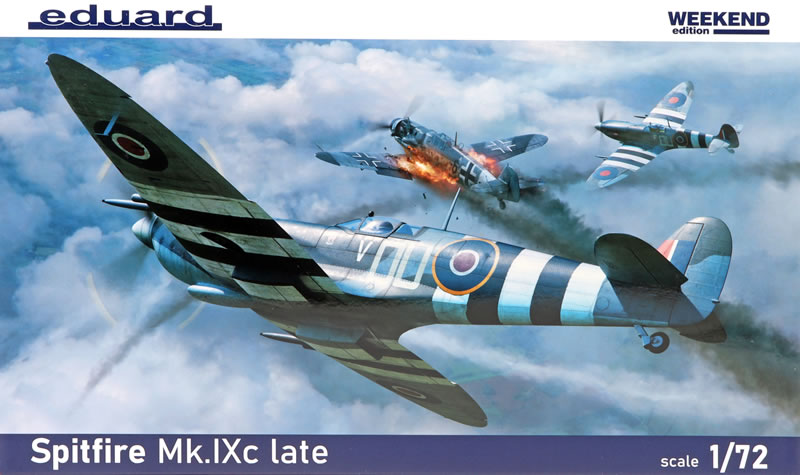
Eduard Weekend Edition, 1/72 scale
| S u m m a r y : |
Catalogue Number: |
Eduard Kit No. 7473 - Spitfire Mk.IXc Late Weekend Edition
|
Scale |
1/72 |
Contents and Media |
More than 150 plastic parts in grey and clear plastic; markings for four aircraft; instructions.
|
Price |
USD$19.95 plus shipping available online from Eduard
GBP£11.99 EU Price (£9.99 Export Price) plus shipping available online from Hannants
and specialist hobby retailers worldwide |
Review Type |
First Look |
Advantages |
Well-moulded with plenty of options, clear instructions, good variety of schemes and clearly the best later Spitfire around. Plenty of additions to your spares box!
|
Disadvantages |
None noted. |
Conclusion |
It is great to see yet another iteration of this terrific kit in the ‘One True Scale’ and it comes thoroughly recommended to the Spitfire addict, and who isn’t? And how nice to see the wartime iteration of the ‘Grace Spitfire’. |
Reviewed by Graham Carter

Yet another iteration of the original Eduard 1/72 Supermarine Spitfire released in late 2016 with the late version of the Mark IX. It was well-received due to its level of detail, fit and accuracy as well as the good range of schemes provided. It was followed by a large number of releases of the Marks IX, VIII and XVI family, all based on the same or similar sets of sprues as the kit contains an enormous number of alternate parts to cover these variants both in Profipack (which offered more detail in the form of masks, coloured PE and more schemes), Weekend Edition with fewer optional schemes, but with the same parts, and the ‘Overtrees’ editions with just a bag of parts so that you can use up some of these spare decal choices..

The kit has been released nearly thirty times according to my search of Scalemates (q.v.) in several versions with some extra parts, different decal choices and varying accessories.
This latest release comes in the usual enormous box which does mean the parts have rattled around quite a bit in transit, although no damage appears to have been done as each sprue is packed in its own bag. These boxes could easily have been 2/3 the size, but they are both strong and top opening. I fitted six completed 1/72 Spitfires inside the bottom of the box with plenty of room for padding. This one comes with a great illustration of one of the decal choices, ML407/OU-V of the 485 (NZ) Squadron flown by F/O John Houlton, working with a partner to down an Me Bf109 in June 1944, and has the four decal choices illustrated on the box side in colour. The importance of this machine is that it survived and was rebuilt as the famous ‘Grace Spitfire’ and still flies today at Duxford.
Those of you who have seen these splendid kits before will be familiar with mass of finely moulded parts (over 150 of them) including all relevant rudder shapes, wing-tips, cockpit details, tanks and weapons and the famous ‘pinwheel’ for the transparencies in different styles and catering for open and closed positions. The parts themselves are beautifully moulded in dark grey plastic with no sign of short-shots or flash beyond a wisp of a seam that will be doddle to remove with a blade or sanding stick. Sprue gates are minimal and are not attached to critical areas of the parts. Each sprue comes in a resealable clear sleeve. The review kit is the Weekend Edition and so does not contain the masks for the canopies or a PE set for all the small parts such as radiator innards, belts and instrument panel. These are provided as perfectly good decals.
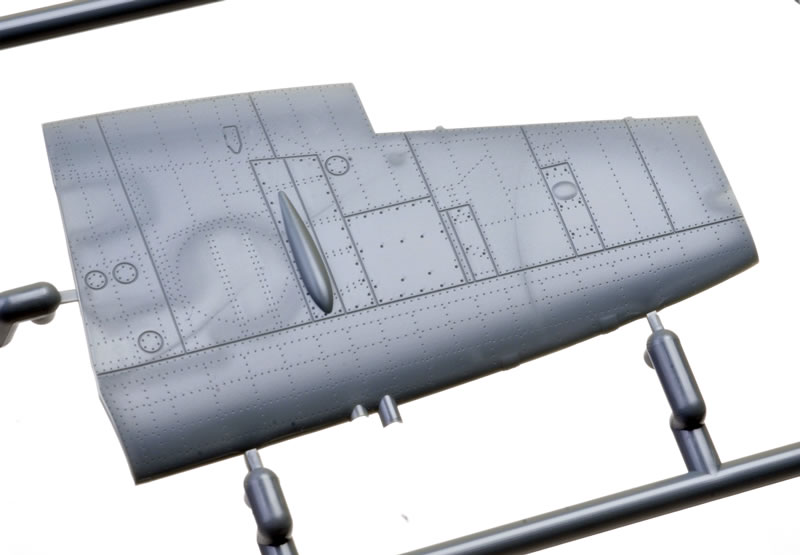
Numerous resin and PE accessory sets are available for these kits, some by Eduard themselves but quite honestly, I can’t see the need as the parts are so finely done; oh, alright, maybe the u/c doors look better in etch!
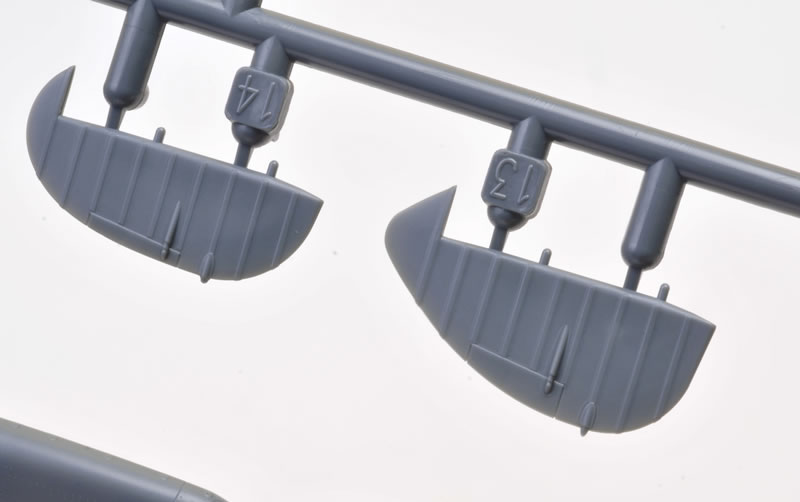
For this kit, more than 85 parts are not used so your spares box will benefit a mass of extras, or you could use them to improve any of the other kits on the market. This does raise the issue of the care you will need to take in sorting out exactly which parts are needed for the model you are building. Fortunately the instructions are very clear about the parts to be used. I would be very tempted to remove those extras from the sprues when I start in order to avoid later confusion.
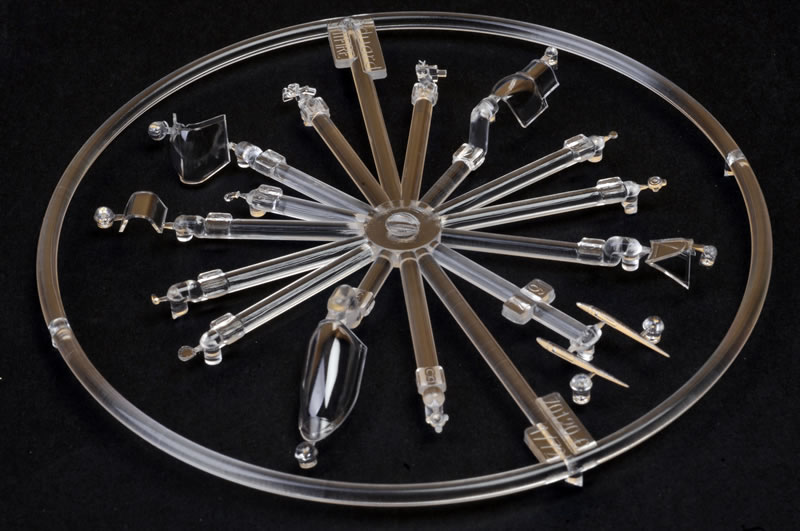
This ‘C’ version comes with the narrow bulges on the upper wings. I thought it was a good idea to do the wheels and tyres as separate parts to both allow different hub types and to make painting easier, saving that awkward masking or hand-painting job. Undercarriage legs are also set at the correct side and forward angles to add accuracy.
The interior is built up as a tub that fits inside the fuselage when being joined up.
Markings
The A4 stapled instruction booklet starts with a brief history of this iconic fighter and then illustrates each step with coloured line-drawings with the schemes being shown in four views and colour. The kit includes a stencil placement diagram, again in four views – very thorough. Colours are indicated clearly at each step and are given only in Gunze Aqueous on a table below the parts map on page 2.
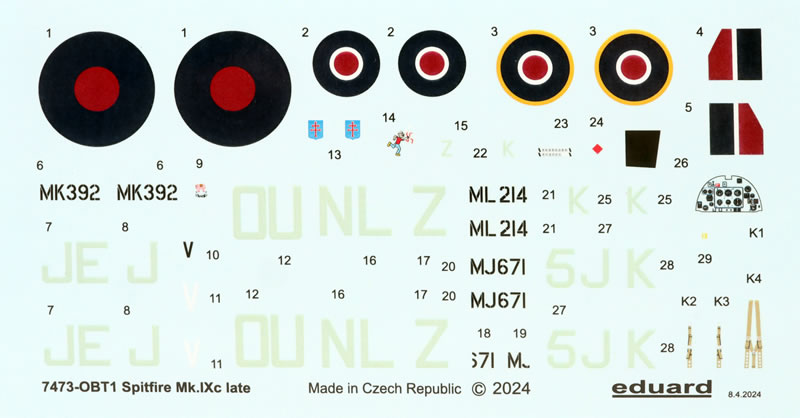
The decal choices are each illustrated with four-view drawings in colour. As usual they are beautifully printed, glossy, thin and perfectly in register. A separate sheet contains a mass of stencilling for one aircraft. The four choices are :-
-
ML407/OU-V of the 485 (NZ) Squadron flown by F/O John Houlton, in the standard Ocean Grey/ Dark Green over Medium Sea Grey with a full set of upper and lower B&W ID bands that obliterate the serial, and yellow leading edges.
-
MK392 JE-J of W/Cdr James ‘Johnnie’ Johnson 144 Wing in June 1944, in the same scheme but a full set of black and white ID bands on wings and rear fuselage that are further forward so that a Sky tail band and the serial is visible in part,
-
MJ671, NL-Z ,Cne Michael Boudier 341 Sqn, June-July 1944, in the same scheme but the black and white ID bands are on lower wings and lower rear fuselage only, and
-
ML214, 5J-K of S/Ldr John Plagis, 126 Sqn in June-July 1944, in the same scheme as ‘3’ above
A splendid kit, well up to the best in the modern modelling world, and these appear to be capable of being made up into absolutely cracking little replicas by almost any standard of modeller and, in the hands of an expert, will be class winners at any show. Highly recommended to the Spitfire addict, and it’s great to see the ‘Grace Spitfire’ in kit form.
Thanks to Eduard for the sample

Review Text & Images Copyright © 2023 by Graham Carter
Images Copyright © 2023 by Brett Green
Page Created 31 January, 2023
Last updated
7 August, 2024
Back to HyperScale Main Page
Back to Reviews Page |
